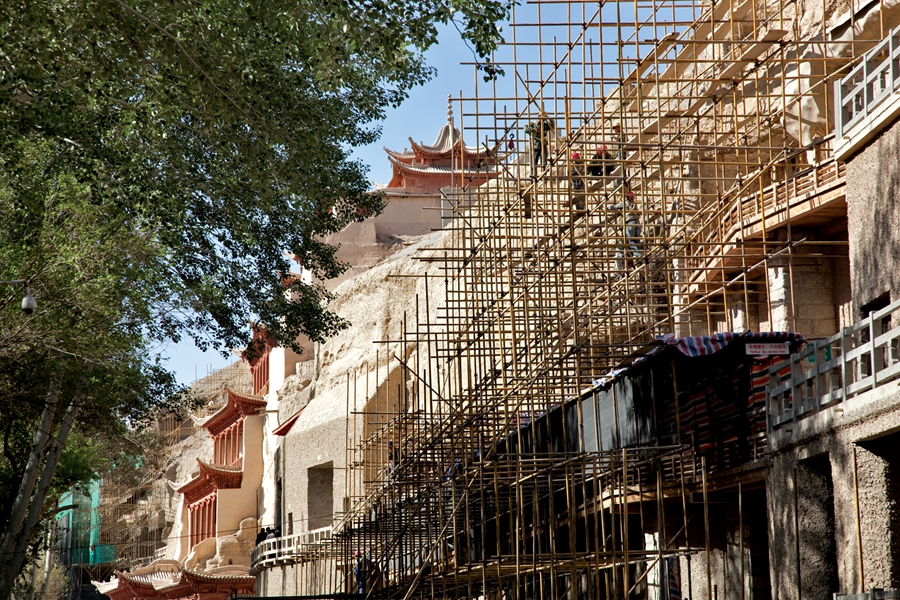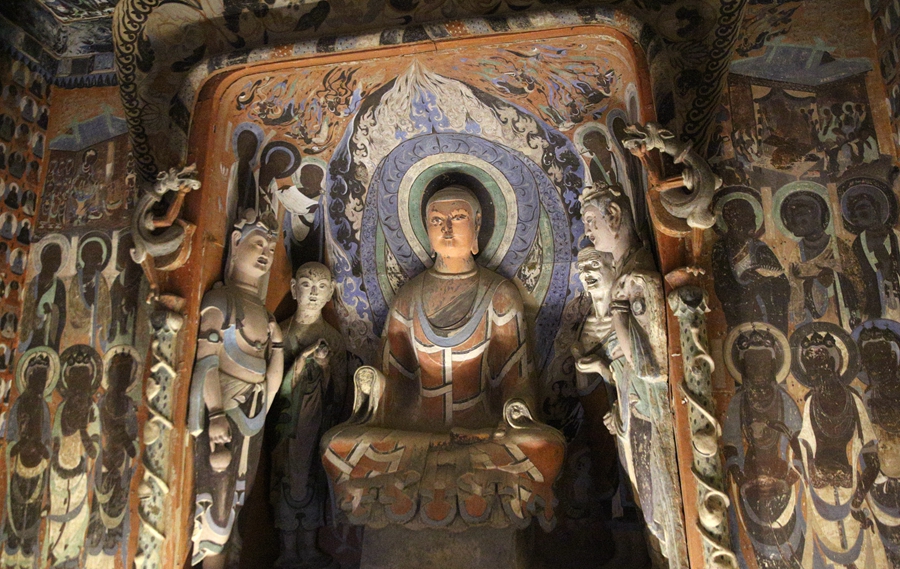 Dunhuang Academy director looks to iconic Mogao Caves art in renewed global role for Chinese culture, Alexis Hooi and Wang Linyan report. They are often depicted drifting through the air, descending from the heavens among wisps of clouds and wearing silken robes that convey the lightness of their flight. The apsaras, angel-like beings known as feitian in Chinese, are a symbol of the historic Silk Road oasis of Dunhuang in Gansu province. Common motifs in the city range from towering sculptures of ethereal musicians clutching Chinese pipa lutes at crossroads, to intricate drawings of winsome beauties bearing floral tributes enameled on mugs. For Dunhuang Academy director Zhao Shengliang, the feitian also offer an important way to "brand "traditional Chinese culture and help spread an appreciation of it across the world. "When people think about traditional Chinese culture, they'll think about the Dunhuang feitian, about the beauty of its art." Zhao, 55, was speaking to China Daily on the grounds of the academy in one of his first major interviews since he took up the position earlier this year. The leading research institute manages and studies the nearby Mogao Caves, one of the greatest repositories of ancient Buddhist art dating back to the 4th century, covering the golden age of the Tang (618-907) and other seminal dynasties. The monumental impact of the murals, sculptures, scripts and other major artifacts discovered in the 500 or so caves at the UNESCO World Heritage Site on the outskirts of the oasis in the early 20th century continues to be felt beyond the cultural, historical and religious spheres. Zhao lists tapping Dunhuang art and its legacy to promote Chinese culture to the world as a top priority for the academy. The academy has grown over the seven decades since the establishment of the People's Republic of China and "our development, our direction, has essentially remained unchanged", says Zhao, who is the fifth person to head the institution. His predecessor, Wang Xudong, is the current director of the Palace Museum in Beijing. "Our main responsibility is to protect, research and promote. These are still what we do because first, you need to effectively protect the cultural relics. Then you need to research them well. It's only after researching them well that we are able to understand what they are, what they are composed of, what their value is," Zhao says. "Finally, we can properly develop and promote the value of these priceless treasures."  Better conservation Promoting the Dunhuang legacy involves "upgrading and improving" the academy's conservation and research work, Zhao says. Building on the international collaborations, technological advances and conservation achievements of the past decades, the academy has successfully preserved Mogao's artifacts, but the efforts must now be upgraded, from the repair and restoration of the relics, to the prevention of any damage to them, he says. The academy now includes a monitoring center, which receives data constantly transmitted from every cave. If there are any changes in the air in the caves, such as higher humidity levels, employees will be alerted. "We have to think about measures to prevent any potential problems from occurring," Zhao says. "This preventive approach has been taken to a new level. Domestically, we are probably at the forefront of these efforts." "Of course, it's not perfect yet. There are still many areas that need to be worked on. For instance, there are the seismic type of conditions, which even include the impact of ground movements from tourists," he says. As part of the academy's latest conservation measures, public access to more than 100 Mogao caves is rotated, with limits set on daily visitor numbers to lessen the human and environmental impact on the sites. Research on the relics has also made remarkable strides, with the academy's scholars sharing their expertise with other heritage sites in developing countries and expanding their academic exchanges in recent years. The director himself is a specialist in art history. Born in Zhaotong city, Yunnan province, Zhao headed straight to Dunhuang in 1984 after graduating from Beijing Normal University, against the advice of his father who worried about the harsh conditions at the site. Zhao persevered, fueled by his constant fascination for the relics in front of him and the sense of their importance beyond the caves containing them. He subsequently took the opportunity to study in Japan and earned his doctorate.  Reaching out Research in Dunhuang has come a long way since those early years, when a common phrase among many researchers used to be, "Dunhuang is in China, but studies on it occur abroad", according to Zhao. "As a country with global cultural heritage sites, China now has a responsibility to help other nations with cultural relics to carry out important conservation work," he says. "Dunhuang Academy, of course, needs to help the country with some of that responsibility. This includes academic exchanges on topics such as the Silk Road, which covers many aspects of the ancient Silk Road, stretching millennia and covering the culture and the arts. But there are many other areas deserving of research." The academy has worked with countries such as Kyrgyzstan, Uzbekistan, Iran, Turkey and India. "Through the art of Dunhuang, we take on the role of cultural diplomacy. We can allow more people, allow more countries, to understand Dunhuang art. Understanding Dunhuang art means understanding traditional Chinese art. That way, we can tell China's story and showcase China's traditional culture to the world," Zhao says. The push to promote Dunhuang art globally rides on its ancient role and legacy as a hub of exchanges between East and West, he says. "Dunhuang offers a major lens, a major representation, of traditional Chinese culture." And exhibitions have been held to promote Dunhuang art around the world-in Japan, the United States, Europe, and countries along the Silk Road. The academy is also in the middle of a major digitization drive, using the latest imaging and recording technology to archive and present its relics through online, 3D, virtual tours and other state-of-the-art renditions. "We will continue to produce these exhibitions which have met with wide appeal in wherever they take place," Zhao says. "As the art of Dunhuang is very special, and it is a crystallization of Silk Road exchange, Westerners, and people in Central Asia, East Asia and India, sense in Dunhuang art a familiarity with their own ancient art. It appeals to them. "Through Dunhuang art, they can see the influences of ancient Greece, of Persia in Central Asia, of India …the Chinese may not notice them, but Westerners, they are very interested in these aspects of familiarity." For example, in 2016, the academy held an exhibition in the US. "Before that, there were concerns over whether people there would understand Dunhuang art. Would Americans understand Chinese culture? But once our exhibition started, it attracted many people. There were long lines every day in Los Angeles."  Promoting culture The challenge now is for the academy to nurture the younger generation and develop talent in novel ways to take on the crucial role of promoting Chinese culture, Zhao says. "Beyond the promotion and development of Dunhuang art, we are also focusing on creative cultural areas." A creative cultural research center has been set up at the academy. Animation artists are working on designing products and are also involved in artistic education. They offer children the chance to sketch the art at Dunhuang firsthand, which helps them develop an interest in it from a young age and appreciate its beauty. "Of course, we can't do this alone. We need to work together with society, with enterprises, to help us promote these things," Zhao says. The director says he hopes that more people, particularly those involved in the arts, will visit Dunhuang, "to feel this place, be inspired, to learn its art, its culture, and then spread news about it, and hopefully create some new art that belongs to our times". The academy has worked with the Beijing Institute of Fashion Technology. A group of designers visited Dunhuang to learn about its particular styles, subsequently coming up with some fashion for contemporary times. "In that way they help spread and promote our traditional culture," he says. "I hope we can cover more fields, including industrial design, that can draw inspiration from Dunhuang. "That way, we can enrich modern society." Artists today need, more than ever, to build on the foundations of traditional culture to create and establish a firm footing internationally, Zhao says. Developing and promoting China's cultural heritage also requires a dedicated team of specialists who are able to explore and tap multiple channels of communication, he says. "Many people, when they come to Dunhuang, they go into the dimly lit caves. They can't see much, and they can't understand what they see. How do you promote something like that? "We need a team of people to take on this role, introduce Dunhuang, and teach people how to appreciate its intricacies and details that make it so appealing," Zhao says. "Where is the value, what is special about the art? That needs to be explained to a wider audience. Perhaps it can be explained through books and classes. And artists can also use their medium. For instance, they can communicate with younger people through exhibitions and animations." These approaches in turn allow Dunhuang's legacy to become infused in society and appreciated at all levels, finding their way to the ground-and appearing even as apsaras on cups, Zhao says. "The hope is for the younger generation to better grasp the beauty of Dunhuang art … as a major representation of traditional Chinese art. Then it can really flourish."
|
 |Archiver|小黑屋|丝路遗产丝绸之路:长安天山廊道的路网
( 陕ICP备07011065号-3 )
|Archiver|小黑屋|丝路遗产丝绸之路:长安天山廊道的路网
( 陕ICP备07011065号-3 )
GMT+8, 2025-7-6 03:05 , Processed in 0.368254 second(s), 21 queries .
Powered by Discuz! X3.5
© 2001-2024 Discuz! Team.